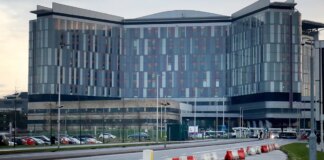One by one, the bodies of 54 unidentified Palestinians, which had been handed over by Israeli authorities, were buried in the sandy soil of Deir al-Balah, Gaza, on Wednesday, as the exchange of remains between Israel and Hamas continues.
The Israeli military said the deceased had been combatants in the Gaza Strip, an assertion that The New York Times could not independently verify.
After prayers at the burial ceremony, officials from the Hamas-backed government media office addressed reporters. Flags of an allied militant group, Palestinian Islamic Jihad, fluttered behind the officials.
Forensic doctors at Gaza’s Nasser Hospital, which received the remains, say they have been unable to identify roughly two-thirds of the bodies.
That has left Gazan health officials and families with many unanswered questions about who the dead were, the circumstances of their deaths and what had happened to them before they died.
“They are burying people with no names, no way to know who they are,” said Motwakel al-Degran, 54, who was at the burial ceremony in Deir al-Balah, adding that his two sons and son-in-law were missing. “Being here is the least I could do as a father, because maybe they are there among the bodies.”
Under the terms of a cease-fire deal, which came into effect earlier this month, Israel is required to release the bodies of 15 deceased Palestinian prisoners in exchange for every deceased Israeli hostage returned by Hamas.
So far, Hamas has returned the bodies of at least 15 people to Israel. For its part, Israel has returned the bodies of almost 200 deceased Palestinians.
Some of the bodies returned to Gaza were in a troubling state, according to Dr. Ahmed Dheir, a senior forensic specialist at Nasser Hospital. He said that many bore signs of traumatic injuries, and all were unidentified save for a number assigned by Israel.
In a statement in relation to those allegations, the Israeli military said that it “operates strictly in accordance with international law.”
The cornerstone of this month’s cease-fire deal was a hostage-and-prisoner exchange on Oct. 13, when Hamas released the remaining 20 Israeli hostages in Gaza in exchange for the release of almost 2,000 Palestinian prisoners and detainees.
The return of the deceased has been less straightforward, because Hamas says that two years of war have made it difficult to locate and retrieve bodies from damaged or destroyed buildings.
Israeli officials have said they expected Hamas to return the deceased Israeli hostages at a faster pace, and some have accused the militant group of failing to abide by the terms of the cease-fire.
Vice President JD Vance, on a visit to Israel on Tuesday, urged patience regarding the recovery of the remaining bodies, saying that some remains are buried under thousands of pounds of rubble.
“It is a focus of everybody here to get those bodies back home to their families so that they can have a proper burial,” he said, adding, “This is not going to happen overnight.”
Despite the tension caused by this dispute, and recent flare-ups of violence in Gaza, both Israel and Hamas say they remain committed to the truce.
It has been difficult for the authorities in Gaza to identify bodies returned so far because the decimated local health system lacks the capacity to do DNA testing. But 50 of those bodies have been identified by their families and given private funerals, Dr. Dheir said.
He described those sad family reunions as “success under extremely limited conditions.”
The rest of the unidentified bodies were awaiting future burial, he said.
Some of the mourners at the mass burial on Wednesday said they had gone to Nasser Hospital again and again since the cease-fire, trying to find their missing loved ones.
Among those mourners was Howaida Ali Hammad, 60, who said she had been searching for her 24-year-old nephew, Ahmed Sufian Abu Hadda.
“I come here every day to see if I can recognize him, his clothes, his face, anything,” she said, her voice trembling. “It’s unfair to bury these bodies without knowing who they are.”
Ismail al-Thawabta, a spokesman for the Hamas-backed government media office, said DNA samples had been taken from the bodies, so their families might be able to identify them one day. Until then, he said, they would remain in the cemetery at Deir al-Balah.
“This is a way to preserve their dignity,” said Mr. al-Thawabta. “But we expect this place will soon be full.”
Reem Hammad, 21, was at the graveside in Deir al-Balah as the bulldozers lowered bodies into the ground.
“It’s unbearable to watch,” she said. “I can’t imagine how it feels for a mother to stand here, unsure if one of these bodies is her son.”
Johnatan Reiss contributed reporting.





